树其实是范畴更广的图的特例
通过前面的学习,我们知道,有序数组可以利用二分查找法快速的查找特定的值,时间复杂度为O(log2N),但是插入数据时很慢,时间复杂度为O(N);链表的插入和删除速度都很快,时间复杂度为O(1),但是查找特定值很慢,时间复杂度为O(N)。
那么,有没有一种数据结构既能像有序数组那样快速的查找数据,又能像链表那样快速的插入数据呢?树就能满足这种要求。不过依然是以算法的复杂度为代价
在编程的世界里,有一个真理叫“复杂度守恒定律”,一个程序当它降低了一个方面的复杂度,必然会在其他方面增加复杂度。这就跟谈恋爱一样,也没有无缘无故的爱,没有无缘无故的恨,当你跟程序谈恋爱时,没有无缘无故的易用性,也没有无缘无故的复杂度
1 树的相关概念
我们先从广义上来讨论一下树的概念
树其实是范畴更广的图的特例
下面是一个普通的非二叉树
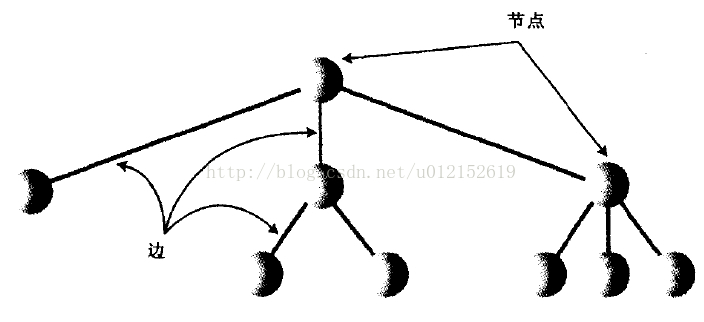
在程序中,节点一般用来表示实体,也就是数据结构里存储的那些数据项,在java这样的面向对象的编程语言中,常用节点来表示对象
节点间的边表示关联节点间的路径,沿着路径,从一个节点到另一个节点很容易,也很快,在树中,从一个节点到另一个节点的唯一方法就是顺着边前进。java语言中,常用引用来表示边(C/C++中一般使用指针)
树的顶层总是只有一个节点,它通过边连接到第二层的多个节点,然后第二层也可以通过边连接到第三层,以此类推。所以树的顶部小,底部大,呈倒金字塔型,这和现实世界中的树是相反的
如果树的每个节点最多有两个子节点,则称为二叉树。如果节点的子节点可以多余两个,称为多路树
有很多关于树的术语,在这里不做过多的文字解释,下面给出一个图例,通过它可以直观地理解树的路径、根、父节点、子节点、叶节点、子树、层等概念
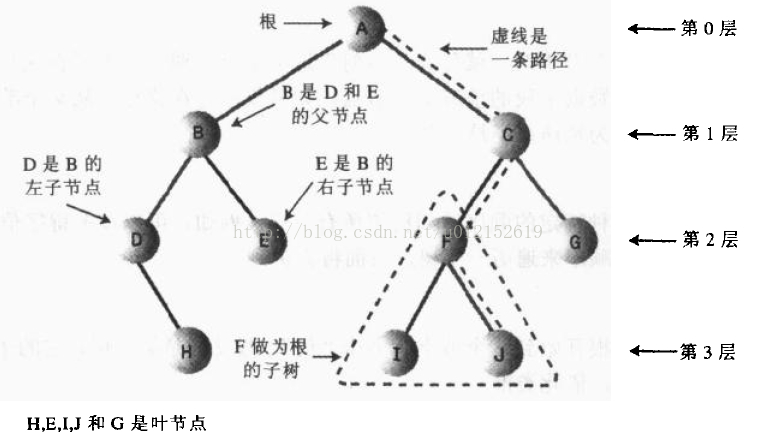
需要注意的是,从树的根到任意节点有且只有一条路径可以到达,下图所示就不是一棵树,它违背了这一原则
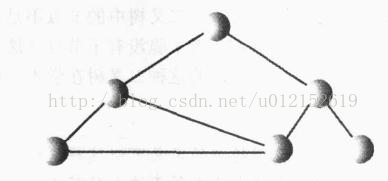
2 二叉搜索树
我们从一种特殊的、使用很广泛的二叉树入手:二叉搜索树。
二叉搜索树的特点是,一个节点的左子节点的关键字值小于这个节点,右子节点的关键字值大于或等于这个父节点。下图就是一个二叉搜索树的示例: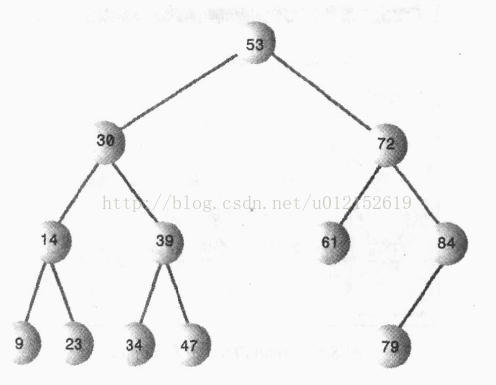
关于树,还有一个平衡树与非平衡树的概念。非平衡就是说树的大部分节点在根的一边,如下图所示:
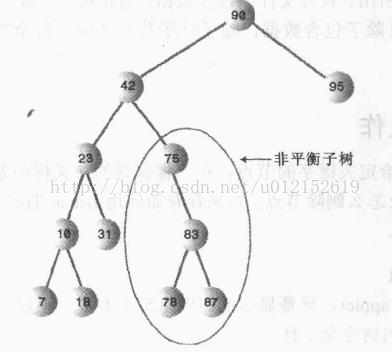
树的不平衡是由数据项插入的顺序造成的。如果关键字是随机插入的,树会更趋向于平衡,如果插入顺序是升序或者降序,则所有的值都是右子节点或左子节点,这样生成的树就会不平衡了。非平衡树的效率会严重退化
接下来我们就用java语言实现一个二叉搜索树,并给出查找、插入、遍历、删除节点的方法
首先要有一个封装节点的类,这个类包含节点的数据以及它的左子节点和右子节点的引用
1
2
3
4
5
6
7
8
9
10
11
12
13
14
15
16
17
|
public class Node {
int age;
String name;
Node leftChild;
Node rightChild;
public Node(int age,String name){
this.age = age;
this.name = name;
}
public void displayNode(){
System.out.println("name:"+name+",age:"+age);
}
}
|
以上age,name两个属性用来代表该节点存储的信息,更好的方法是将这些属性封装成一个对象,例如:
1
2
3
4
5
6
7
8
9
10
11
12
13
14
15
16
17
18
19
20
21
| Person{
private int age;
private String name;
public void setAge(int age){
this.age = age;
}
public int getAge(){
return this.age;
}
public void setName(String name){
this.name = name;
}
public String getName(){
return this.name;
}
}
|
这样做才更符合“面向对象”的编程思想。不过现在我们的重点是数据结构而非编程思想,所以在程序中简化了
由于树的结构和算法相对复杂,我们先逐步分析一下查找、插入等操作的思路,然后再写出整个的java类
2.1 查找
我们已经知道,二叉搜索树的特点是左子节点小于父节点,右子节点大于或等于父节点。查找某个节点时,先从根节点入手,如果该元素值小于根节点,则转向左子节点,否则转向右子节点,以此类推,直到找到该节点,或者到最后一个叶子节点依然没有找到,则证明树中没有该节点
比如我们要在树中查找57,执行的搜索路线如下图所示:
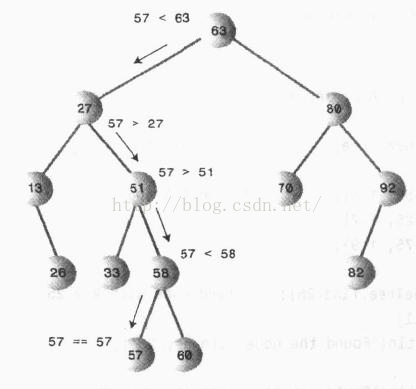
2.2 插入
插入一个新节点首先要确定插入的位置,这个过程类似于查找一个不存在的节点。如下图所示:
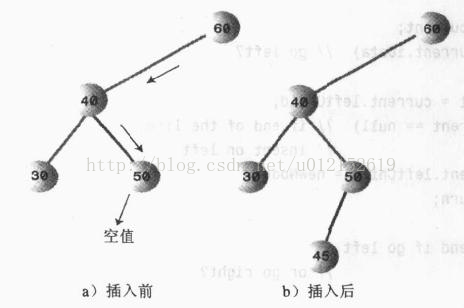
找到要插入的位置之后,将父节点的左子节点或者右子节点指向新节点即可
2.3 遍历
遍历的意思是根据一种特定顺序访问树的每一个节点
有三种简单的方法遍历树:前序遍历、中序遍历、后序遍历。二叉搜索树最常用的方法是中序遍历,中序遍历二叉搜索树会使所有的节点按关键字升序被访问到
遍历树最简单的方法是递归。用该方法时,只需要做三件事(初始化时这个节点是根):
1、调用自身来遍历节点的左子树
2、访问这个节点
3、调用自身来遍历节点的右子树
遍历可以应用于任何二叉树,而不只是二叉搜索树。遍历的节点并不关心节点的关键字值,它只看这个节点是否有子节点
下图展示了中序遍历的过程
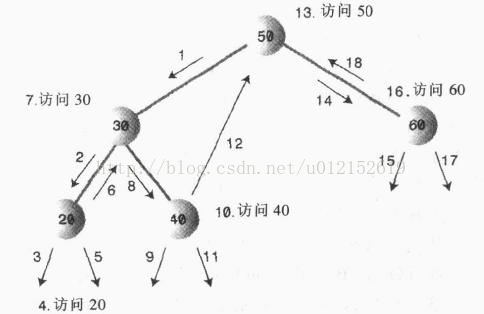
对于每个节点来说,都是先访问它的左子节点,然后访问自己,然后在访问右子节点
如果是前序遍历呢?就是先访问父节点,然后左子节点,最后右子节点;同理,后序遍历就是先访问左子节点,在访问右子节点,最后访问父节点。所谓的前序、中序、后序是针对父节点的访问顺序而言的
2.4 查找最值
在二叉搜索树中,查找最大值、最小是是很容易实现的,从根循环访问左子节点,直到该节点没有左子节点为止,该节点就是最小值;从根循环访问右子节点,直到该节点没有右子节点为止,该节点就是最大值
下图就展示了查找最小值的过程:
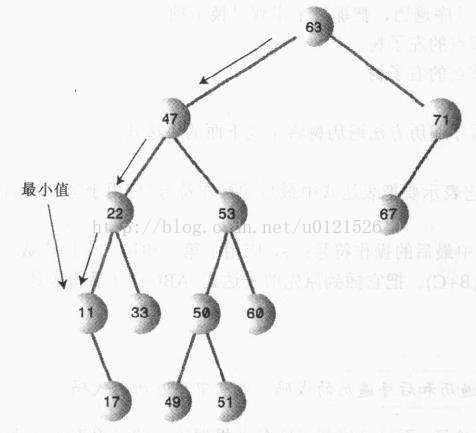
2.5 删除节点
树的删除节点操作是最复杂的一项操作。该操作需要考虑三种情况考虑:
1、该节点没有子节点
2、该节点有一个子节点
3、该节点有两个子节点
第一种没有子节点的情况很简单,只需将父节点指向它的引用设置为null即可:
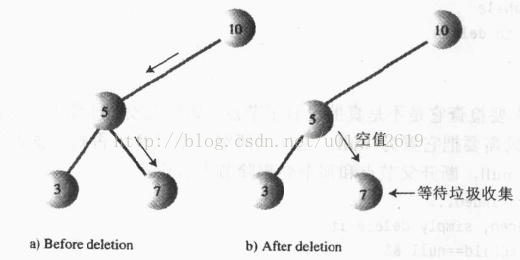
第二种情况也不是很难,这个节点有两个连接需要处理:父节点指向它的引用和它指向子节点的引用。无论要删除的节点下面有多复杂的子树,只需要将它的子树上移:

还有一种特殊情况需要考虑,就是要删除的是根节点,这时就需要把它唯一的子节点设置成根节点
下面来看最复杂的第三种情况:要删除的节点由连个子节点。显然,这时候不能简单地将子节点上移,因为该节点有两个节点,右子节点上移之后,该右子节点的左子节点和右子节点又怎么安排呢?
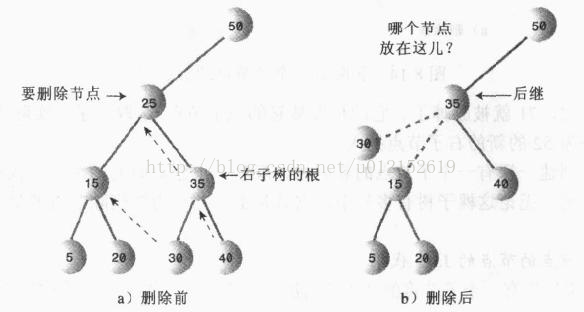
这时应该想起,二叉搜索树是按照关键升序排列,对每一个关键字来说,比它关键字值高的节点是它的中序后继,简称后继。删除有两个子节点的节点,应该用它的中序后继来替代该节点
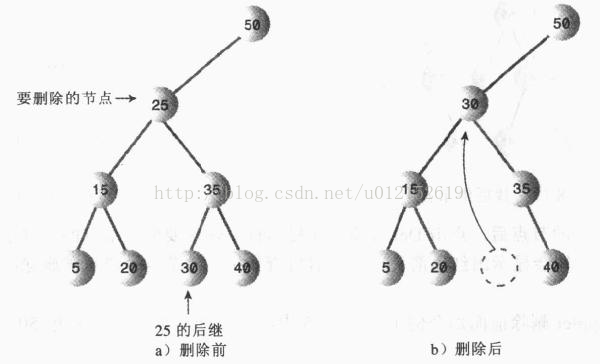
上图中,我们先列出中序遍历的顺序:
5 15 20 25 30 35 40
可以看到,25的后继是30,所以应该用30来替代25的位置。实际上就是找到比欲删除节点的关键字值大的集合中的最小值。从树的结构上来说,就是从欲删除节点的右子节点开始,依次跳到下一层的左子节点,直到该左子节点没有左子节点为止。下图就是找后继节点的示例: 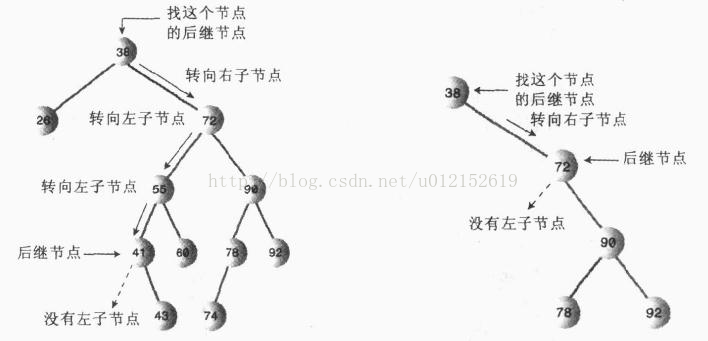
从上图中可以看到,后继结点有两种情况:一种是欲删除节点的右子节点没有左子节点,那么它本身就是后继节点,此时,只需要将以此后继节点为根的子树移到欲删除节点的位置:
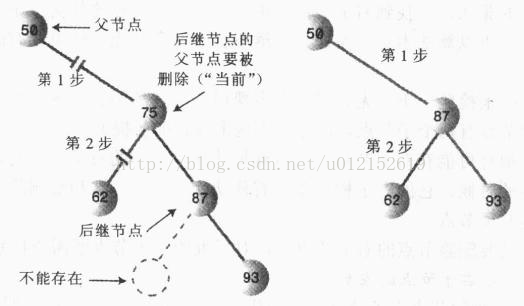
另一种情况是欲删除节点的右子节点有左子节点,这种情况就比较复杂,下面来逐步分析。首先应该意识到,后继节点是肯定没有左子节点的,但是可能会有右子节点
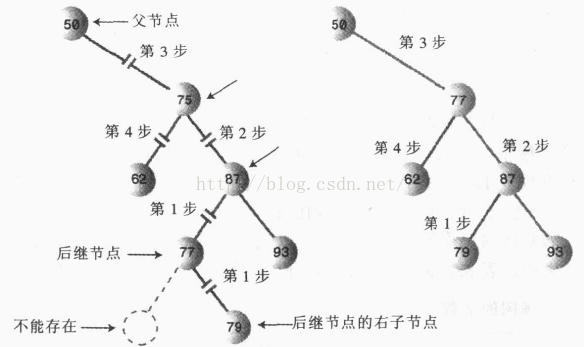
上图中,75为欲删除节点,77为它的后继节点,树变化的步骤如下:
1、把87的左子节点设置为79;
2、把77的右子节点设为以87为根的子树;
3、把50的右子节点设置为以77为根的子树;
4、把77的左子节点设置为62
到此为止,删除操作终于分析完毕,包含了所有可能出现的情况。可见,二叉树的删除是一件非常棘手的工作,那么我们就该反思了,删除是必须要做的任务吗?有没有一种方法避开这种烦人的操作?有困难要上,没有困难创造困难也要上的二货精神是不能提倡的
在删除操作不是很多的情况下,可以在节点类中增加一个布尔字段,来作为该节点是否已删除的标志。在进行其他操作,比如查找时,之前对该节点是否已删除进行判断。这种思路有点逃避责任,但是在很多时候还是很管用的。本例中为了更好的深入理解二叉树,会采用原始的、复杂的删除方法
下面我们就根据上面的分析,写出一个完整的二叉搜索树类,该类中,如果有重复值,插入到右子节点,查找时也只返回第一个找到的节点
1
2
3
4
5
6
7
8
9
10
11
12
13
14
15
16
17
18
19
20
21
22
23
24
25
26
27
28
29
30
31
32
33
34
35
36
37
38
39
40
41
42
43
44
45
46
47
48
49
50
51
52
53
54
55
56
57
58
59
60
61
62
63
64
65
66
67
68
69
70
71
72
73
74
75
76
77
78
79
80
81
82
83
84
85
86
87
88
89
90
91
92
93
94
95
96
97
98
99
100
101
102
103
104
105
106
107
108
109
110
111
112
113
114
115
116
117
118
119
120
121
122
123
124
125
126
127
128
129
130
131
132
133
134
135
136
137
138
139
140
141
142
143
144
145
146
147
148
149
150
151
152
153
154
155
156
157
158
159
160
161
162
163
164
165
166
167
168
169
170
171
172
173
174
175
176
177
178
179
180
181
182
183
184
185
186
187
188
189
190
191
192
193
194
195
196
197
198
199
200
201
202
203
204
205
206
207
208
209
210
211
212
213
214
215
216
217
218
219
220
221
222
223
224
225
226
227
228
229
230
231
232
233
234
235
236
237
238
239
240
241
242
243
244
245
246
247
248
249
250
251
252
253
254
255
256
257
258
259
260
261
262
263
264
265
266
267
268
269
270
271
272
273
274
275
276
277
278
279
280
281
282
283
284
285
286
287
288
289
290
291
292
293
294
295
296
297
298
299
300
301
302
303
304
305
306
307
308
309
310
311
312
313
314
315
316
317
318
319
| import java.util.ArrayList;
import java.util.List;
public class BinaryTree {
private Node root;
public BinaryTree(){
root = null;
}
public Node find(int key){
Node cur = root;
if(cur == null){
return null;
}
while(cur.age != key){
if(key < cur.age){
cur = cur.leftChild;
}else{
cur = cur.rightChild;
}
if(cur == null){
return null;
}
}
return cur;
}
public void insert(Node node){
if(root == null){
root = node;
}else{
Node cur = root;
while(true){
if(node.age < cur.age){
if(cur.leftChild == null){
cur.leftChild = node;
return;
}
cur = cur.leftChild;
}else{
if(cur.rightChild == null){
cur.rightChild = node;
return;
}
cur = cur.rightChild;
}
}
}
}
public boolean delete(Node node){
if(root == null){
return false;
}
boolean isLeftChild = true;
Node cur= root;
Node parent = null;
while(cur.age != node.age){
parent = cur;
if(node.age < cur.age){
cur = cur.leftChild;
}else{
isLeftChild = false;
cur = cur.rightChild;
}
if(cur == null){
return false;
}
}
if(cur.leftChild == null && cur.rightChild == null){
if(cur == root){
root = null;
}else if(isLeftChild){
parent.leftChild = null;
}else{
parent.rightChild = null;
}
}else if(cur.leftChild == null){
if(cur == root){
root = cur.rightChild;
}else if(isLeftChild){
parent.leftChild = cur.rightChild;
}else{
parent.rightChild = cur.rightChild;
}
}else if(cur.rightChild == null){
if(cur == root){
root = cur.leftChild;
}else if(isLeftChild){
parent.leftChild = cur.leftChild;
}else{
parent.rightChild = cur.leftChild;
}
}else{
Node successor = cur.rightChild;
Node successorParent = null;
while(successor.leftChild != null){
successorParent = successor;
successor = successor.leftChild;
}
if(successorParent == null){
if(cur == root){
root = successor;
root.leftChild = cur.leftChild;
}else if(isLeftChild){
parent.leftChild = successor;
successor.leftChild = cur.leftChild;
}else{
parent.rightChild = successor;
successor.leftChild = cur.leftChild;
}
}else{
successorParent.leftChild = successor.rightChild;
successor.rightChild = cur.rightChild;
if(cur == root){
root = successor;
root.leftChild = cur.leftChild;
}else if(isLeftChild){
parent.leftChild = successor;
successor.leftChild = cur.leftChild;
}else{
parent.rightChild = successor;
successor.leftChild = cur.leftChild;
}
}
}
return true;
}
public static final int PREORDER = 1;
public static final int INORDER = 2;
public static final int POSTORDER = 3;
public void traverse(int type){
switch(type){
case 1:
System.out.print("前序遍历:\t");
preorder(root);
System.out.println();
break;
case 2:
System.out.print("中序遍历:\t");
inorder(root);
System.out.println();
break;
case 3:
System.out.print("后序遍历:\t");
postorder(root);
System.out.println();
break;
}
}
public void preorder(Node currentRoot){
if(currentRoot != null){
System.out.print(currentRoot.age+"\t");
preorder(currentRoot.leftChild);
preorder(currentRoot.rightChild);
}
}
public void inorder(Node currentRoot){
if(currentRoot != null){
inorder(currentRoot.leftChild);
System.out.print(currentRoot.age+"\t");
inorder(currentRoot.rightChild);
}
}
public void postorder(Node currentRoot){
if(currentRoot != null){
postorder(currentRoot.leftChild);
postorder(currentRoot.rightChild);
System.out.print(currentRoot.age+"\t");
}
}
private int getDepth(Node currentNode,int initDeep){
int deep = initDeep;
int leftDeep = initDeep;
int rightDeep = initDeep;
if(currentNode.leftChild != null){
leftDeep = getDepth(currentNode.leftChild, deep+1);
}
if(currentNode.rightChild != null){
rightDeep = getDepth(currentNode.rightChild, deep+1);
}
return Math.max(leftDeep, rightDeep);
}
public int getTreeDepth(){
if(root == null){
return 0;
}
return getDepth(root,1);
}
public Node getMax(){
if(isEmpty()){
return null;
}
Node cur = root;
while(cur.rightChild != null){
cur = cur.rightChild;
}
return cur;
}
public Node getMin(){
if(isEmpty()){
return null;
}
Node cur = root;
while(cur.leftChild != null){
cur = cur.leftChild;
}
return cur;
}
public void displayTree(){
int depth = getTreeDepth();
ArrayList<Node> currentLayerNodes = new ArrayList<Node> ();
currentLayerNodes.add(root);
int layerIndex = 1;
while(layerIndex <= depth){
int NodeBlankNum = (int)Math.pow(2, depth-layerIndex)-1;
for(int i = 0;i<currentLayerNodes.size();i++){
Node node = currentLayerNodes.get(i);
printBlank(NodeBlankNum);
if(node == null){
System.out.print("*\t");
}else{
System.out.print("* "+node.age+"\t");
}
printBlank(NodeBlankNum);
System.out.print("*\t");
}
System.out.println();
layerIndex++;
currentLayerNodes = getAllNodeOfThisLayer(currentLayerNodes);
}
}
private ArrayList getAllNodeOfThisLayer(List parentNodes){
ArrayList list = new ArrayList<Node>();
Node parentNode;
for(int i=0;i<parentNodes.size();i++){
parentNode = (Node)parentNodes.get(i);
if(parentNode != null){
if(parentNode.leftChild != null){
list.add(parentNode.leftChild);
}else{
list.add(null);
}
if(parentNode.rightChild != null){
list.add(parentNode.rightChild);
}else{
list.add(null);
}
}else{
list.add(null);
list.add(null);
}
}
return list;
}
private void printBlank(int num){
for(int i=0;i<num;i++){
System.out.print("*\t");
}
}
public boolean isEmpty(){
return (root == null);
}
public boolean isLeaf(Node node){
return (node.leftChild != null || node.rightChild != null);
}
public Node getRoot(){
return root;
}
}
|
参考链接















